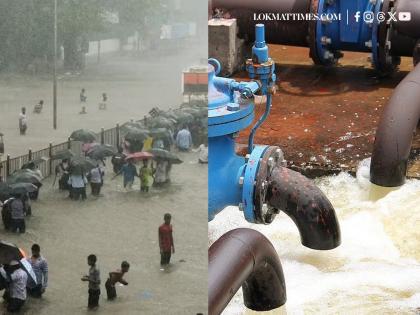Mumbai Rains: How Did BMC Pumps Drain 1,645 Crore Litres in Just Four Days?
By Lokmat Times Desk | Updated: August 19, 2025 19:21 IST2025-08-19T19:20:56+5:302025-08-19T19:21:07+5:30
Since August 16, Mumbai has been grappling with continuous heavy rainfall, yet the city has managed to avoid catastrophic ...

Mumbai Rains: How Did BMC Pumps Drain 1,645 Crore Litres in Just Four Days?
Since August 16, Mumbai has been grappling with continuous heavy rainfall, yet the city has managed to avoid catastrophic flooding thanks to its network of pumping stations and flood-control systems. Over a span of just four days, the Brihanmumbai Municipal Corporation (BMC) reported that its stations pumped out an astonishing 1,645 crore litres of rainwater. To put this in perspective, the volume exceeds twice the storage capacity of Tulsi Lake. These numbers highlight both the vulnerability of Mumbai during monsoons and the indispensable role played by its pumping infrastructure in keeping daily life functional.
Mumbai currently relies on six major pumping stations located at Irla, Cleveland Bunder, Gazdarbandh, Lovegrove, Haji Ali, and Britannia. Collectively, these facilities operate 43 high-capacity pumps, each capable of draining 6,000 litres of water per second. Together, their combined capacity reaches 2.58 lakh litres every second. During the most recent spell of torrential rain, these pumps functioned nonstop for nearly 761 hours. Among them, the Irla station in Juhu played the most crucial role, removing over 3,768 million litres alone, while Cleveland Bunder and Gazdarbandh followed closely with about 3,000 million litres each.
Read More: Tirupati: Balaji Mandir Receives Record Gold Donation Worth ₹140 Crore
Even the relatively smaller Britannia station at Reay Road proved significant by pumping out around 1,700 million litres of rainwater. To further combat sudden waterlogging in vulnerable low-lying zones, the BMC strategically deployed 540 portable pumps throughout the city. Their importance was evident on August 19, when torrential downpours returned, and these mobile pumps drained nearly 182.5 crore litres within just six hours. Teams of trained municipal staff worked around the clock in three dedicated shifts to operate the equipment, ensuring the city’s flood-prone areas received immediate attention.
Suburban regions such as Kurla, Andheri, and Chembur, historically notorious for severe flooding, particularly benefitted from these interventions. Local residents reported that this year, water receded far faster than they had previously experienced, reducing the disruption to their lives. The rainfall intensity added to the challenge, with multiple neighbourhoods recording over 300 mm within 24 hours on August 18 and 19. Chincholi in the western suburbs topped the charts at 361 mm, followed by Kandivali at 337 mm, while Dadar and Wadala also reported over 280 mm during the same period.
The downpour was relentless, with the city recording more than 100 mm of rain between 4 am and 8 am on August 19 alone in several areas such as Foras Road, Versova, and Mulund. Yet despite the intensity, the difference was clear: suburban trains continued to run, flights operated with only minimal delays, and neighbourhoods reopened quickly compared to previous monsoons. While waterlogging did occur in some pockets, it failed to bring Mumbai to a complete standstill, proving the efficiency of the pumping network in preventing a large-scale civic crisis.
With meteorological agencies predicting further heavy rainfall, the BMC’s pumping stations are expected to continue their round-the-clock operations. As Mumbai weathers yet another season of relentless monsoon downpours, it is the city’s hidden “army of pumps” that has emerged as its unsung guardian. Quietly and efficiently, these machines and the workers who run them are ensuring that life in India’s financial capital remains afloat despite nature’s fury.
Open in app